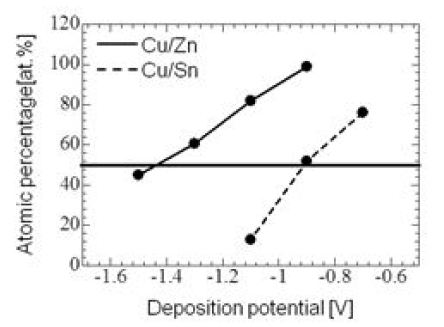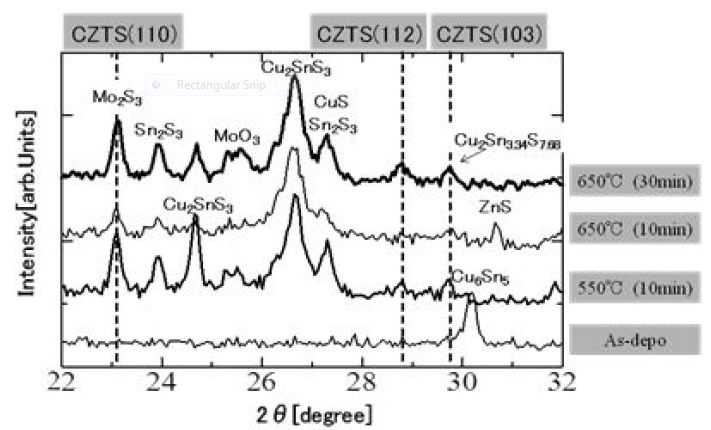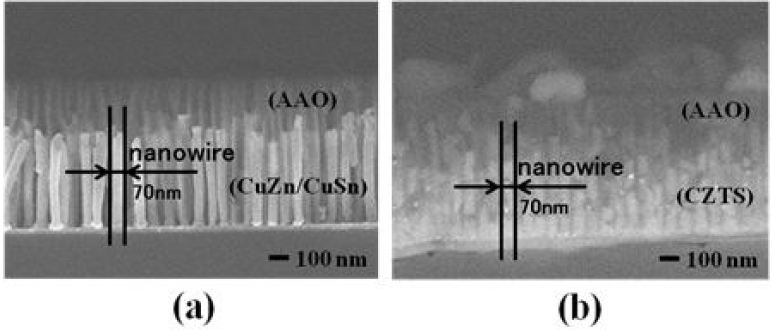Top Links
Journal of Materials Science and Nanotechnology
ISSN: 2348-9812
Fabrication of Vertical Cu2ZnSnS4 Nanowire Arrays by Two-Step Electroplating Method into Anodic Aluminum Oxide Template
Copyright: © 2014 Wang CE. This is an open-access article distributed under the terms of the Creative Commons Attribution License, which permits unrestricted use, distribution, and reproduction in any medium, provided the original author and source are credited.
Related article at Pubmed, Google Scholar
Vertical Cu2ZnSnS4 (CZTS) nanowire arrays have been synthesized via two-step electroplating method into anodized aluminum oxide template. For deposition of CZTS nanowires, anodized aluminum oxide (AAO) was used as the growth mask for the growth of the nanowires. AAO templates with hole sizes of 70 nm in diameter were used in the experiments. After electroplating of CuZu/CuSn, vertical CuZu/CuSn nanowires were obtained on Mo-coated Si substrates and the typical size of nanowire and AAO of the same size. And the elemental compositions of unannealed CuZu/CuSn nanowires about 2:1:1. Sulfurization was performed at 600 0C for 10 min in CS2+Ar atmosphere. X-ray diffraction patterns indicate that the annealed CZTS have a kesterite structure including secondary metal and metal sulfide phases. It is found that the conditions of sulfurization treatment affect the quality of CZTS absorber layer.
CZTS materials is one of the most promising solar cell materials to replace CIGS (Cu (In,Ga)S2 or Cu(In,Ga)Se2) absorber layer materials. In spite of CIGS the high efficiency nearly 20% [1], however, due to containing expensive rare metals of Indium and Gallium, furthermore, CIGS contain toxic element Se, leading to a solar cell with environmental disadvantage. Therefore, a research about the CZTS solar cell as a new material device is carried out. CZTS has been confirmed as a promising alternative material for low cost absorber layer in solar cells because of except for the optical-electronic properties similar with CIGS, the CZTS materials containing the earth-abundant chemical elements of Zn and Sn, and non –toxicity. Furthermore, it has a suitable optical band gap 1.4 ~ 1.50 eV and a sufficient absorption coefficient of 1× 104 cm-1 for application of solar cells [2,3].
Specific to the structure of solar cell, an absorber thickness of roughly 1 to 2μm is required to ensure high absorption efficiency for the solar cell. However, this will result in a long diffusion length leading to significant recombination. Nanowire solar cells offer the potential of significant increase in the absorber efficiency of the cells by decoupling the absorption thickness and the diffusion distance [4]. The use of one-dimensional (1D) technology can offer semiconductors a well-aligned morphology with clearly identifiable grain boundaries, where an energy barrier exists and prevents charge carrier recombination [5,6]. In addition, the well-aligned nanowires may provide continuous charge carrier transport pathways. These characteristics would lead to increase in conversion efficiency in the photovoltaic devices [7].
In recent years, fabrications of CZTS absorber layer using the sol-thermal, sol-gel [8-12] and the electroplating method [13-16] have been reported. Electroplating method has several advantages, such as simple, low cost, non-vacuum, large area deposition and room temperature growth. In 2011 year, our research group reported that fabrication of CZTS thin films and nanowires by single-step electroplating method [17]. The CZTS thin film and nanowire with kesterite structure have been formed, however, it is difficult to control the composition ratio of CZTS. In this study, we synthesize CZTS thin films and nanowires by two-step electroplating method with AAO template (The use of AAO as a template for fabrication of nanowires is well known and documented in the literature [18,19]) and the sulfurization temperature were change. The structural, morphological and compositional characteristics of the CZTS nanowires and thin films were investigated and discussed.
Firstly, we have fabricated CZTS thin films, to optimize electroplating conditions for nanowires fabrication. Figure 1. A■1 - A■4 shows the main experiment processes for the synthesis of CZTS thin films. First, Mo was deposited by sputtering, after sputtering CuZn thin film was deposited on Mo-coated Si substrates by electroplating method. Before deposition, the Mo surface was cleaned ultrasonically in acetone, ethanol and distilled water and dried by flowing nitrogen. Subsequently, CuSn thin films was deposited on CuZn thin film, then, the deposited films were annealed an 550 °C~650 °C in sulfur atmosphere. All of the electroplating processes were performed in a Hokuto Denko model HZ-5000 Potentiostat/Galvanostat with a three electrode configuration. The electrochemical cell contains a saturated Ag/AgCl electrode as a reference electrode; a platinum (Pt) electrode as an inert counter electrode and Mo-coated substrate with a deposition area of 1.5×1 cm2 was used as the working electrode.
The CuZn thin film was prepared from aqueous electrolytic bath containing 0.01M copper (II) sulfate pentahydrate (CuSO4-5H2O), 0.2M zinc sulfate heptahydrate (ZnSO4-7H2O), 1M tri-sodium citrate (C6H5Na3O7:Na3-citrate) as complexing agent and NaOH as pH control solution were used. The CuSn thin films were prepared from aqueous electrolytic bath containing 0.02M copper (II) sulfate pentahydrate (CuSO4-5H2O), 0.2M SnCl2, 0.5M tri-sodium citrate (C6H5Na3O7:Na3-citrate) as complexing agent. For the formation of CuZn and CuSn thin films, the deposition potential were varied from -1.5V to -0.7V. The chemical compositions of the CuZn thin film and CuSn thin film with different deposition potential were shown in Figure 2. When the CuZn deposition potential was -1.3V and the CuSn was -0.9V, nearly stoichiometric composition was obtained. The deposited films were annealed at 550 °C to 650 °C in CS2 + Ar atmosphere.
We have fabricated CZTS nanowires using optimize electroplating conditions into AAO template. Figure 1. B■1 - B■5 shows the experiment processes of CZTS nanonwires. First, Mo and Al films were deposited on Si substrates by sputtering, and the Al films were anodized in 0.3 M oxalic acid at 40V potential. After anodization, the AAO nanoholes were enlarged, and the AAO bottom barrier layer was removed by pore-widening treatment with 5 wt% diluted phosphoric acid for 5 minutes at 30 OC. Subsequently, CuZn and CuSn were alternately electroplated into AAO nanoholes using the same electroplating condition of deposit thin films. After electroplating, AAO mask was completely removed from Mo surface using diluted phosphoric acid (5 wt%) for 1 hour. The deposited nanowires were sulfurized of at 600 OC for 10 min. We used the electroplating conditions, which had been optimized for preparation of CZTS nanowires in our previous study.
The overall crystal structure of the sample is examined by X-ray diffraction (XRD, Philips X-ray with CuKα radiation, λ= 1.5406 Å). The general morphology of the samples was characterized using scanning electron microscopy (SEM, Model: JSM-3000F, JEOL, and Japan). The chemical composition of CZTS nanowires and thin films were examined using scanning electron microscopy attached with EDS.
Figure 3 shows XRD patterns of sulfurized CZTS thin films deposited with different annealing temperature. It is seen that all the XRD patterns consist of (100), (112) and (103) diffraction peaks corresponding to different crystallographic planes of CZTS, suggesting that the films are polycrystalline with kesterite crystal structure. From the XRD results, some metal sulfide and other secondary phases, such as CuxS, SnSx, CuxSny, and CuxSnySz were also detected. These secondary phases are often observed in CZTS thin films during the formation process, particularly for the copper-rich chalcopyrite samples [20-23]. From these results, we realized that annealing conditions affect the surface morphologies of prepared CZTS thin film.
The SEM images of the CZTS nanowires are shown in Figure 4. From Figure 4a, it can be seen that the vertical CuZn/CuSn nanowires were obtained by two-step electroplating method with AAO template, and the CZTS nanowires' diameter and average length were 70nm and 500 nm. The geometry of the CZTS nanowires, such as diameter and density, can be controlled by the geometry of AAO nanoholes. Figure 4b shows the CZTS nanowire arrays after sulfurization at 600 0C for 10 min in CS2+Ar atmosphere with AAO nanoholes. It can be observed nanowires were still vertical on the Mo-coated Si substrate. We found that the formed nanowires were vertical to the substrate. This can provide the potential application and research for one-dimension solar cells.
Vertical CZTS nanowires were fabricated on Mo-coated Si substrates by two-step electroplating method, employing nanoporous anodic aluminum oxide as a template. About the chemical compositions of the CuZn and CuSn with different deposition potential, when the CuZn deposition potential was -1.3V and the CuSn was -0.9V, nearly stoichiometric composition was obtained. The element compositions of CuZn/CuSn nanowires about 2:1:1 was obtained. From the morphology studies, we can conclude that the obtained nanowires are vertical to the substrate. X-ray diffraction patterns indicate that the annealed CZTS thin films have a kesterite structure including secondary metal and metal sulfide phases. We have found that the quality of CZTS nanowires strongly depends on the annealing conditions.
This work is supported by the Grant - in - Aid for Scientific Research 20241027 of JSPS, and Strategic Project to Support the Formation of Research Bases at Private Universities: Matching Fund Subsidy from MEXT (Ministry of Education, Culture, Sports, Science and Technology).
 |
| Figure 1: Schematics of the sample preparation (A) Schematics of the CZTS thin film preparation (A■1) Mo film is sputtered on Si substrate. (A■2) CuZn thin film is deposited by electroplating. (A■3) CuSn thin film is deposited by electroplating on CuZn thin film. (A■4) Annealing in CS2+Ar gas atmosphere carried out the sulfurization of CuZn/CuSn thin films. (B) Schematics of the CZTS nanowires preparation (B■1) Mo and Al films were deposited on Si substrates by sputtering. (B■2) Al films were anodized in 0.3 M oxalic acid. After anodization, AAO pore slightly etched to remove the alumina layer at the pore bottom. (B■3) CuZn and CuSn were alternately electroplated into AAO nanopores. (B■4) AAO was removed from Mo thin film. (B■5) Annealing in CS2+Ar gas atmosphere carried out the sulfurization of CuZn/CuSn nanowires. |
 |
| Figure 2: Variation CuZn and CuSn thin films atomic percentage with deposition potential. |
 |
| Figure 3: XRD patterns of as-deposited CZTS precursor thin film and CZTS thin films annealed at varies annealing temperatures from 550 0C to 650 0C |
 |
| Figure 4: SEM and TEM images of electroplated CuZn/CuSn nanowires for as-depositied and after sulfurization: (a) Cross-section SEM image of as-deposited CuZn/CuSn nanowires. (b) after sulfurization at 600 oC for 10 min in CS2+Ar atmosphere with AAO nanoholes. |






































